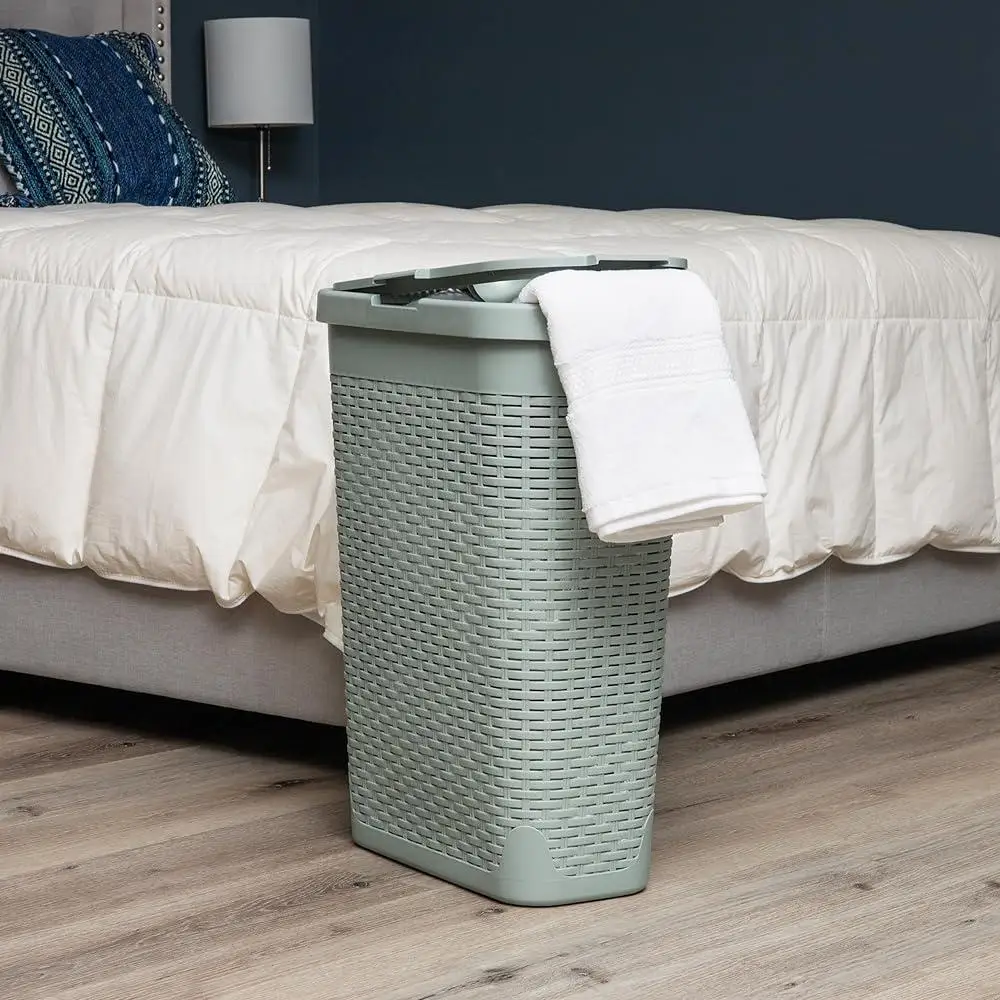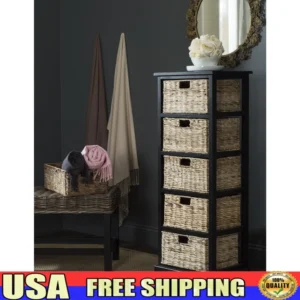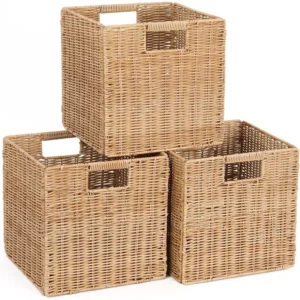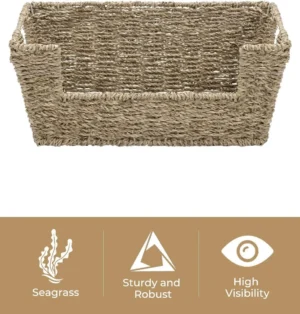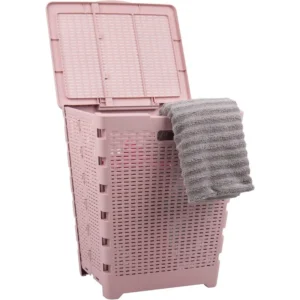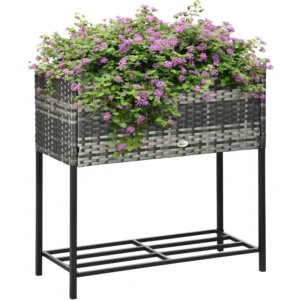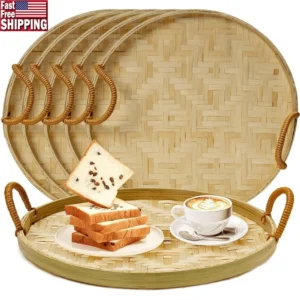Understanding Hampers and Baskets: Key Definitions and Differences
When organizing your home, two classic storage solutions often come to mind: hampers and baskets. While these terms are sometimes used interchangeably, they actually refer to distinct items with unique characteristics and purposes.
A hamper is traditionally a large, sturdy container with a lid. The word “hamper” comes from the French “hanaper,” a medieval drinking vessel. Today’s hampers are typically designed for specific storage purposes, featuring enclosed construction that conceals contents and often includes a secure lid. Most hampers are crafted from sturdy materials like wicker, rattan, or heavy-duty fabric and frequently include liners to protect the contents and the container itself.
Baskets, on the other hand, are open containers made from woven materials. The term derives from the Latin “bascauda,” and baskets have been used across civilizations for thousands of years. Unlike hampers, baskets are typically open-topped, allowing for easy access and visibility of contents. They’re versatile tools for transportation, display, and organization.
Understanding the fundamental differences between laundry hampers and baskets helps you select the right option for your specific needs. These differences extend beyond mere appearance and affect how these items function in your home.
| Feature | Hampers | Baskets |
|---|---|---|
| Structure | Typically more rigid and sturdy | Can range from flexible to structured |
| Top | Almost always includes a lid | Usually open-topped (some include optional lids) |
| Materials | Traditionally wicker or rattan; modern versions include canvas, plastic | Wider variety: willow, seagrass, fabric, wire, plastic, bamboo |
| Size | Generally larger | Available in all sizes, often smaller |
| Traditional Uses | Laundry storage, picnic supplies, gift collections | Transportation, organization, decorative display |
| Visibility of Contents | Contents concealed | Contents typically visible |
The terminology around these items can vary significantly by region and culture. In some parts of the world, what Americans call hampers might be referred to as linen baskets or clothes bins. Understanding these cultural and regional differences can be helpful when shopping or researching storage options online.
Material Matters: What Hampers and Baskets Are Made From
The materials used in hampers and baskets significantly impact their functionality, appearance, and longevity. Understanding these materials can help you make an informed choice for your home.
Traditional Hamper Materials:
• Wicker: A traditional weaving technique (not a material itself) that creates sturdy, breathable containers perfect for laundry hampers
• Rattan: A climbing palm producing flexible wood that creates sturdy, lightweight hampers with natural visual appeal
• Canvas: Durable fabric often used for collapsible hampers, providing lightweight, washable options
• Synthetic materials: Modern plastics and composites offering water resistance and easy cleaning
Common Basket Materials:
• Willow: Flexible branches creating rustic, traditional baskets with excellent durability
• Bamboo: Sustainable material providing strength and lightweight construction
• Seagrass: Natural fiber creating textural, beach-inspired baskets
• Water hyacinth: Eco-friendly material with a distinctive appearance and surprising durability
• Fabric: Soft, often collapsible baskets ideal for lightweight items
• Wire: Metal baskets offering industrial style and maximum visibility of contents
• Plastic: Affordable, water-resistant options in countless colors and styles
Material choice affects more than aesthetics—it determines durability, weight, and maintenance requirements. Our premium rattan baskets offer exceptional durability while maintaining a natural, organic appearance that elevates any room’s decor.
Environmental considerations also play an important role in material selection. Natural materials like rattan, willow, and seagrass are generally renewable resources, though harvesting practices vary. When choosing between natural wicker vs synthetic options, consider that natural materials often age beautifully but may require more maintenance, while synthetic versions typically offer greater water resistance and lower maintenance.
Care requirements vary significantly by material. Natural fibers require occasional dusting and should be kept away from excessive moisture, while synthetic materials and wire baskets can often be wiped clean or even washed. Understanding these differences helps ensure your storage solution remains beautiful and functional for years to come.
Design Features That Determine Functionality
The structural design of hampers and baskets plays a crucial role in their functionality, often determining which option best suits your specific needs. These design elements aren’t just about appearance—they directly impact how effectively these items serve their purpose.
Key Hamper Design Features:
• Lids: Most hampers feature lids that conceal contents, control odors, and create a neater appearance
• Handles: Side or top handles facilitate transportation, particularly important for laundry hampers
• Compartments: Some hampers include dividers for sorting different types of items
• Liners: Fabric liners protect both the hamper structure and its contents, often removable for washing
• Ventilation: Quality hampers include some airflow design to prevent mustiness, especially for laundry
Essential Basket Design Features:
• Handles: The design of wicker baskets with handles varies widely, from simple cutouts to elaborate rope or leather grips
• Shape variations: From round to rectangular, shallow to deep, affecting storage capacity and use
• Reinforcements: Quality baskets include strengthened rims and bases for durability
• Stackability: Some designs nest or stack to save space when not in use
• Decorative elements: Weaving patterns, color variations, and embellishments
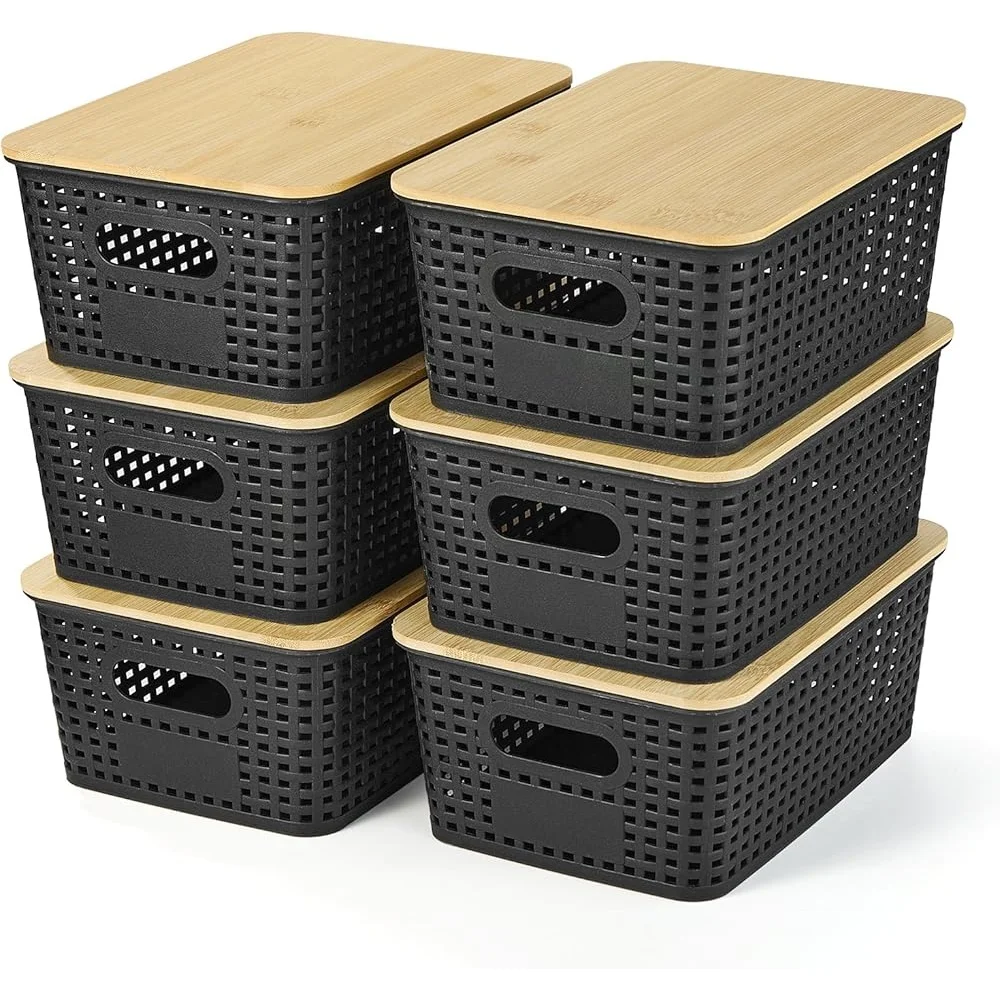
The presence or absence of these design elements significantly impacts practical use. For example, the ongoing debate about laundry basket vs hamper as the perfect companion often centers on design features—hampers conceal dirty clothes and control odors with their lids, while baskets offer easier access and transportation of clean, folded laundry.
Space efficiency is another important consideration. Collapsible designs save space when not in use, while stackable options maximize vertical storage. Some designs even serve double duty as decorative elements and functional storage, making them ideal for small spaces where every item must earn its keep.
Specialized design elements can make certain options perfect for specific uses. For example, picnic hampers often feature specialized compartments for securing dishes and flatware, while craft baskets might include dividers for different supplies. These thoughtful design features transform simple containers into highly effective tools for organization.
Size and Capacity: Choosing the Right Dimensions
Selecting the appropriate size for your hamper or basket is crucial for both functionality and visual harmony in your space. Too small, and you’ll constantly be emptying it; too large, and it may overwhelm your room or go partially unused.
Common Size Ranges for Hampers:
• Small: 12-16 inches tall, 10-14 inches wide (20-40 liter capacity)
• Medium: 17-24 inches tall, 14-18 inches wide (40-60 liter capacity)
• Large: 25-36 inches tall, 18-24 inches wide (60-100+ liter capacity)
Common Size Ranges for Baskets:
• Small: 6-10 inches diameter/length, 3-6 inches height
• Medium: 10-16 inches diameter/length, 6-10 inches height
• Large: 16-24+ inches diameter/length, 10-14+ inches height
When space is limited, understanding the differences between hampers vs baskets for small laundry areas becomes especially important. In tight spaces, tall, narrow hampers often maximize capacity while minimizing floor space usage.
For those needing substantial storage capacity, large wicker baskets offer versatile solutions that combine ample storage with beautiful design. These larger options work well in family rooms, playrooms, or as statement storage pieces in bedrooms.
To determine the right size for your needs:
- Measure your available space, noting both floor area and height restrictions
- Consider the volume of items you’ll typically store
- Account for visual proportion within your room—oversized pieces can become focal points
- Think about frequency of emptying—larger containers require less frequent attention
- Consider weight when full—larger containers become heavier and may be difficult to move
Remember that proper sizing isn’t just about physical fit but also visual scale. A hamper or basket should look proportional to the space it occupies and the furniture around it. In smaller rooms, consider using multiple smaller baskets rather than one oversized option, creating more flexible storage that can be rearranged as needed.
Practical Applications: When to Choose a Hamper
Hampers excel in situations where concealment, containment, and protection of items are priorities. Their enclosed design with lids makes them ideal for specific applications throughout the home.
Laundry Management
The most common use for hampers is storing dirty laundry. Wicker hampers with lids offer several advantages for this purpose:
• Concealment of unsightly dirty clothes
• Odor containment, especially important in bedrooms
• Sorting capability when using multi-section hampers
• Protection from dust and household debris
• Clear visual separation between clean and dirty laundry
When comparing laundry hamper vs basket options, hampers typically win for dirty clothes storage due to their concealing design and odor management capabilities.
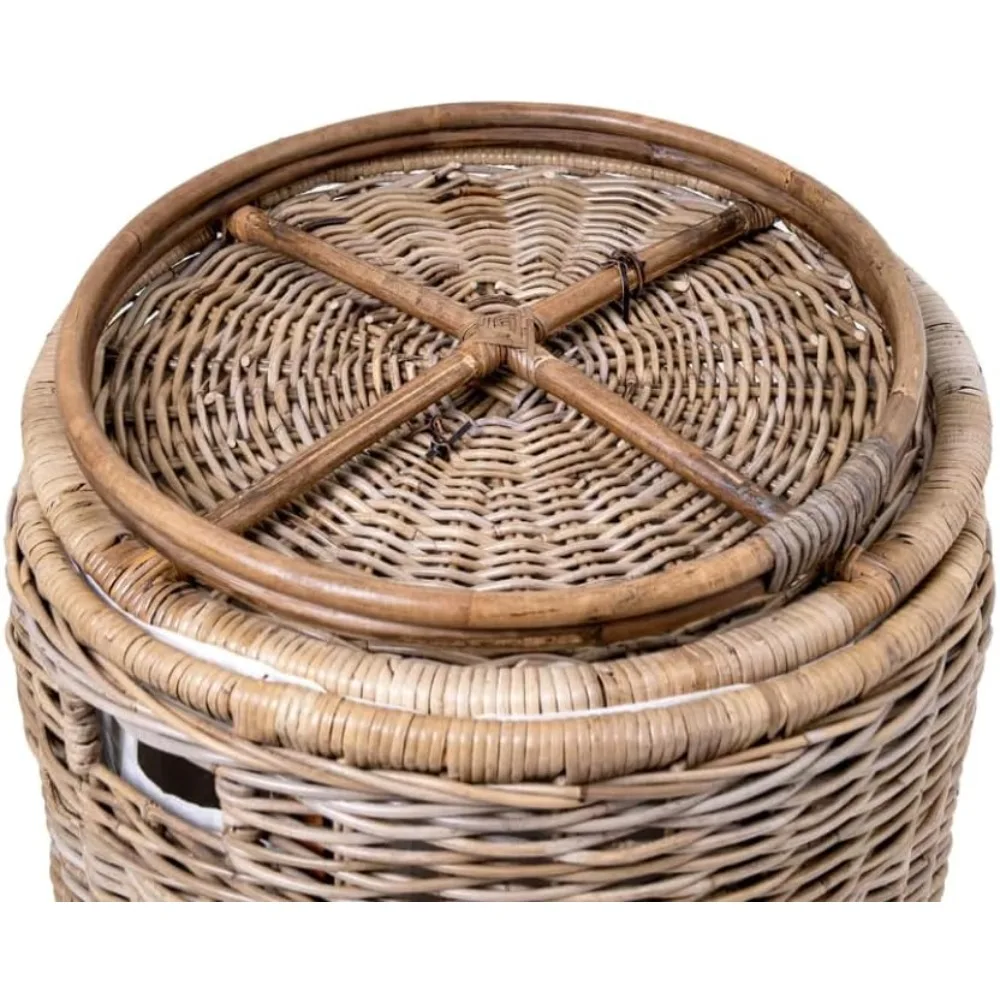
Gift Presentations
High-quality hampers create impressive gift presentations, particularly for:
• Corporate gifting where presentation matters
• Special occasions like weddings and housewarmings
• Food and beverage collections where protection is important
• Luxury gift arrangements with multiple components
• Situations where the container itself is part of the gift
Seasonal Storage
Hampers provide excellent storage for seasonal items:
• Holiday decorations that need protection
• Off-season clothing and accessories
• Special occasion items like party supplies
• Craft and hobby supplies that should be dust-free
• Children’s seasonal toys and equipment
Specialized Storage
The protective nature of hampers makes them ideal for:
• Bathroom linens in humid environments
• Bedding storage with protection from dust
• Picnic supplies that need secure transportation
• Collection and containment of items before sorting
• Storage of delicate or easily damaged items
The enclosed design of hampers creates a sense of order by completely concealing contents, making them perfect for spaces where visual calm is desired. Their substantial presence also allows them to serve as furniture pieces in their own right, with many designs elegant enough to display prominently in living spaces rather than hidden away in closets.
Practical Applications: When to Choose a Basket
Baskets offer accessibility and visibility that make them ideal for different scenarios than hampers. Their open design creates practical advantages for many storage and organizational needs throughout the home.
Accessible Daily Items
Baskets excel at storing frequently used items where quick access is essential:
• Kitchen staples like fruit, bread, and snacks
• Bathroom toiletries and cosmetics
• Remote controls and electronic accessories
• Reading materials like magazines and books
• Craft and hobby supplies used regularly
When considering laundry basket vs hamper options, baskets are typically superior for clean laundry—they allow easy access for folding and retrieving items while providing better visibility of contents.
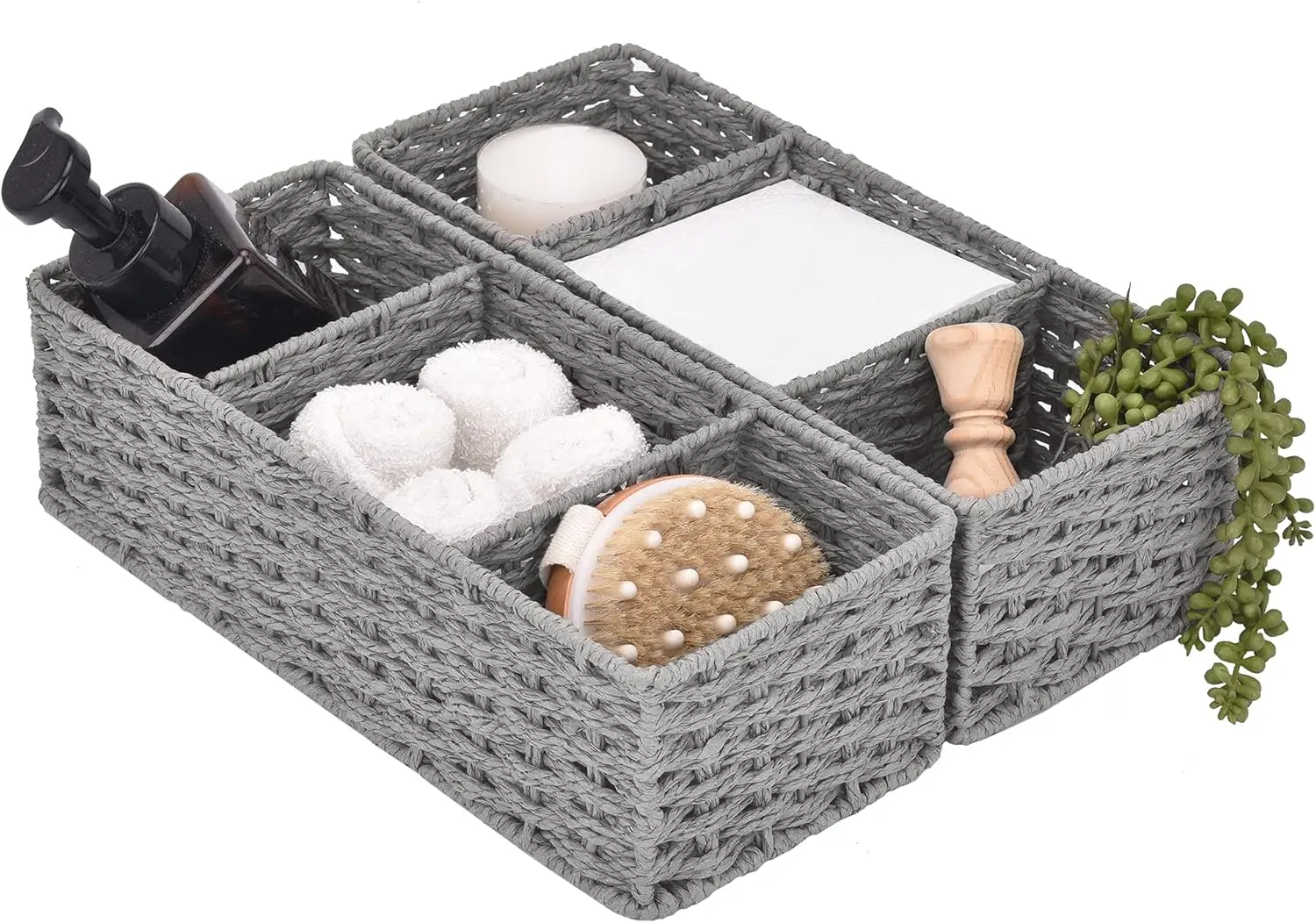
Organizational Systems
Rattan shelf baskets and similar options create effective visual organization systems:
• Pantry organization with visible categorization
• Closet storage for accessories and smaller clothing items
• Office organization for papers and supplies
• Playroom toy sorting and storage
• Garage and utility room organization for small items
Decorative Display
Baskets uniquely combine storage with aesthetic display:
• Living room storage that showcases decorative items
• Throws and pillow storage that adds textural interest
• Plant containers that enhance natural elements
• Wall-mounted display systems for collectibles
• Entryway catch-alls that welcome and organize
Transportation and Mobility
The open, accessible nature of baskets makes them ideal for:
• Market and shopping trips where items are added and removed
• Gardening tasks requiring tool transport
• Cleaning supply organization for movement between rooms
• Project materials that need to be carried to work areas
• Picnic and outdoor dining transport where frequent access is needed
Baskets shine in scenarios where you want to see contents at a glance—for example, when organizing children’s books or craft supplies where visual reminders prompt use. Their typically lighter construction also makes them more suitable for situations where the container will be moved frequently or carried for distances.
Aesthetic Considerations: Integrating with Your Home Decor
Storage solutions like hampers and baskets aren’t just functional items—they’re also design elements that can significantly impact your home’s visual appeal. At Tidy Treasure, we believe in “Organizing Life Beautifully, One Basket at a Time,” recognizing that practical storage can also be aesthetically pleasing.
Style Matching
Different hamper and basket styles complement specific interior design approaches:
• Traditional/Classic: Opt for darker stained wicker, rattan, or wooden hampers with refined weaving patterns and structured shapes
• Modern/Contemporary: Look for clean lines, geometric patterns, and materials like white or black wire, painted rattan, or monochromatic fabric
• Rustic/Farmhouse: Choose natural, unfinished materials like raw willow, honeyed rattan, or seagrass with visible texture and imperfections
• Coastal/Beachy: Select light-colored materials like bleached rattan, seagrass, or rope with relaxed, casual weaving
• Bohemian/Eclectic: Explore colorful options, unusual weaving patterns, or baskets with embellishments like tassels, beads, or pom-poms
Matching baskets with home decor involves considering not just the style but also the color palette and existing textures in your space. The best storage pieces feel intentional rather than like afterthoughts.
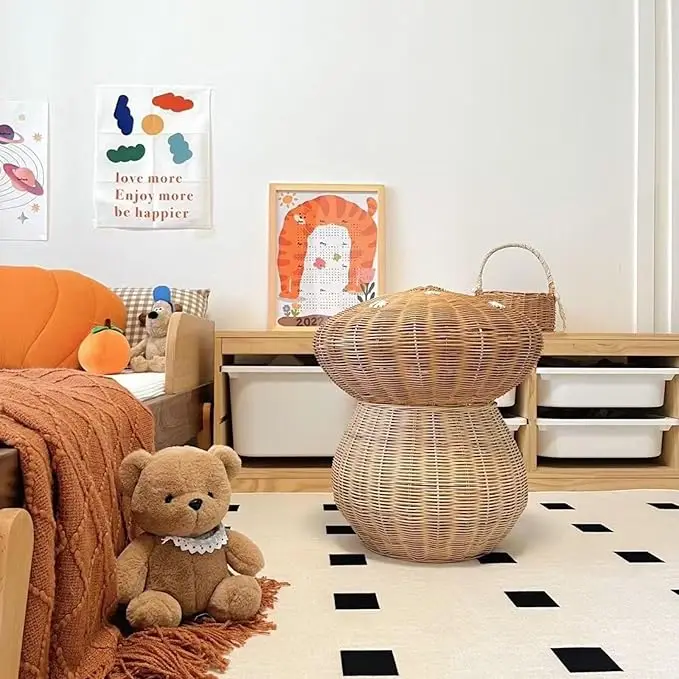
Visual Impact
Consider these factors when evaluating the visual impact of hampers and baskets:
• Scale: Choose sizes proportionate to your space and surrounding furniture
• Repetition: Using multiple similar baskets creates cohesion and visual rhythm
• Contrast: Sometimes a basket in a contrasting material or color creates a striking focal point
• Texture: Woven items add important textural elements to rooms dominated by smooth surfaces
• Pattern: Consider how weaving patterns complement other patterns in your space
Stylish hampers and baskets for the home can transform utilitarian storage into design features that enhance your décor rather than detract from it.
Placement Strategies
Strategic placement maximizes both functionality and visual appeal:
• Position larger hampers as furniture pieces—for example, as end tables or bedside tables
• Group smaller baskets in odd-numbered collections (3 or 5) for visual interest
• Use wall-mounted baskets as three-dimensional art that also provides storage
• Place contrasting baskets on shelves to break up monotony and add visual rhythm
• Layer baskets of different heights to create dimension and interest
Remember that even the most beautiful storage solution becomes less effective when overfilled. Leaving some visual breathing room ensures your hampers and baskets enhance rather than overwhelm your space.
Customization and Personalization Options
Black Wicker Baskets, Rattan Storage Baskets, Tall Wicker Baskets, Wicker Shelf Baskets, Woven Storage Baskets
5-Tier Distressed Black Wood Frame Storage Tower with Removable Wicker Baskets for Home Organization$715.80 Select options This product has multiple variants. The options may be chosen on the product pageRattan Shelf Baskets, Rattan Storage Baskets, Small Wicker Baskets, Square Wicker Baskets
Square Plastic Wicker Storage Baskets Set of 3 with Collapsible Design for Cube Storage Organization$185.47 Select options This product has multiple variants. The options may be chosen on the product pageWicker Baskets with Handles, Wicker Storage Baskets, Woven Storage Baskets
$137.92 Select options This product has multiple variants. The options may be chosen on the product pageWicker Hampers with Lids, Wicker Laundry Baskets with Lids, Wicker Laundry Hampers
$127.33 Select options This product has multiple variants. The options may be chosen on the product pageRattan Shelf Baskets, Rattan Storage Baskets
$345.47 Select options This product has multiple variants. The options may be chosen on the product pageRound Wicker Baskets, Wicker Baskets with Handles, Woven Storage Baskets
$177.30 Select options This product has multiple variants. The options may be chosen on the product page
Personalizing your hampers and baskets allows you to create storage solutions that perfectly match your needs and style preferences. These customization options transform standard items into unique organizational tools tailored specifically to your home.
Liner Options
Liners add both functionality and visual appeal:
• Washable fabric liners for easy cleaning
• Waterproof liners for bathroom or kitchen use
• Padded liners for protecting delicate items
• Decorative liners that add color or pattern
• Custom-sized liners that perfectly fit your basket’s dimensions
Organizational Enhancements
Make your storage more effective with these additions:
• Dividers to create compartments within larger baskets
• Labels or tags for identifying contents at a glance
• Color-coding systems for visual organization
• Inserts that add specialized functionality (like cutlery dividers)
• Stackable inserts that maximize vertical space
Organizing laundry with wicker baskets becomes more efficient with thoughtful customizations like dividers for sorting different types of clothing or labels for family members.
Decorative Additions
Add personal style with these decorative enhancements:
• Ribbon, twine, or rope woven through or wrapped around the exterior
• Paint or stain to match specific color schemes
• Decorative handles replacing original ones
• Appliqués, stencils, or hand-painted designs
• Embellishments like pom-poms, tassels, or beads
Functional Modifications
Adapt standard designs to meet specific needs:
• Adding wheels to the bottom of larger hampers for mobility
• Attaching hooks or handles for hanging
• Adding lids to typically open baskets when needed
• Installing cushioned tops to create seating
• Reinforcing bases for heavier items
Creating coordinated sets from individual pieces helps establish visual cohesion throughout your home. Try using similar customization techniques on different baskets and hampers to create a unified look even when the base items vary in size or shape.
Remember that the best customizations enhance rather than detract from functionality. Prioritize modifications that make your storage solutions work better for your specific needs while also reflecting your personal style.
Maintenance and Care: Ensuring Longevity
Proper care significantly extends the life of your hampers and baskets, ensuring they remain beautiful and functional for years. Different materials require specific maintenance approaches to prevent damage and maintain their appearance.
Natural Fiber Care (Wicker, Rattan, Willow, Seagrass)
• Dust regularly with a soft cloth or vacuum with a brush attachment
• Clean spills immediately with a slightly damp cloth
• Avoid excessive moisture which can cause warping or mildew
• Apply furniture polish or lemon oil occasionally to prevent drying and cracking
• Keep away from direct sunlight to prevent fading and brittleness
Understanding proper basket care and maintenance prevents common issues like splitting, discoloration, and structural weakness that can shorten the lifespan of natural fiber items.
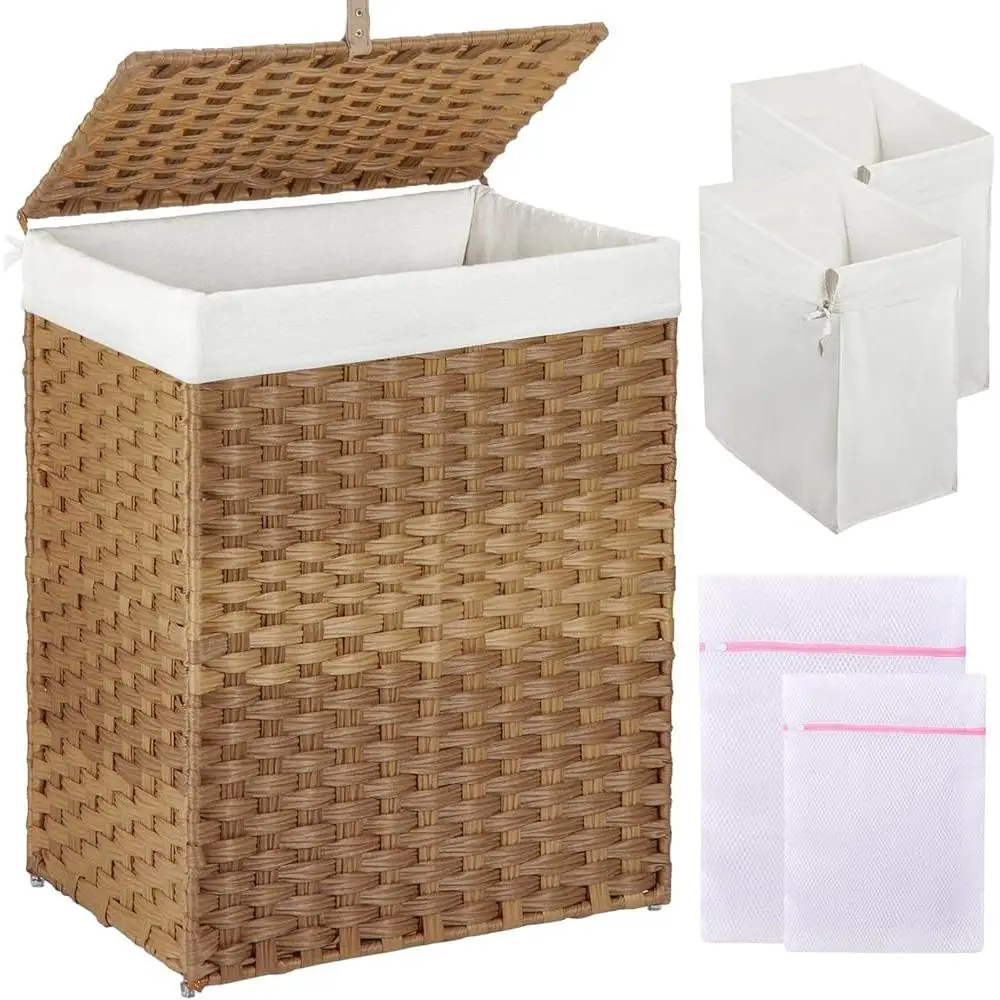
Fabric Hamper Care
• Follow manufacturer’s washing instructions for removable covers
• Spot clean non-removable fabric with appropriate cleaners
• Allow to dry completely before storing anything inside
• Use fabric fresheners between washings for odor control
• Check and tighten structural supports regularly
Wire Basket Maintenance
• Wipe clean with damp cloth and mild detergent
• Check for rust spots and treat immediately
• Apply clear protective spray to prevent future rusting
• Inspect welds and joints for stability
• Add liner if storing items that might fall through openings
Plastic Basket Care
• Clean with mild soap and water
• Avoid abrasive cleaners that can scratch surfaces
• Check for cracks or stress points regularly
• Keep away from high heat sources that could warp the material
• Use UV-protective sprays for outdoor plastic items
Common Issues and Solutions
• Fraying or splitting: Apply a small amount of wood glue and clamp until dry
• Loose weaving: Mist lightly with water and reshape, then allow to dry completely
• Mildew: Clean with diluted white vinegar solution and dry thoroughly in sunlight
• Odors: Sprinkle baking soda inside, let sit overnight, then vacuum
• Squeaking: Apply a small amount of beeswax to joints where friction occurs
Seasonal care makes a difference—increase humidity around natural fiber baskets during dry winter months and ensure proper air circulation during humid summer months. For items used seasonally, proper storage in climate-controlled spaces prevents damage when not in use.
Investment Considerations: Cost vs. Value Analysis
When purchasing hampers and baskets, understanding the relationship between price and value helps you make wise investments in items that will serve you well over time. While initial cost is certainly a consideration, evaluating long-term value provides a more complete picture.
Price Range Overview
Hampers and baskets vary widely in price depending on materials, construction, and brand:
• Budget options: $10-30 for basic plastic, fabric, or mass-produced natural fiber items
• Mid-range options: $30-100 for better quality natural materials with good construction
• Premium options: $100-300+ for high-quality materials, expert craftsmanship, and design excellence
The laundry hampers vs baskets buying guide provides specific insights into making cost-effective choices for laundry storage, one of the most common applications for these items.
Factors Affecting Price
Understanding what drives cost differences helps evaluate whether premium pricing is justified:
• Material quality: Harvesting method, processing technique, and material grade
• Construction method: Hand-weaving versus machine production
• Craftsmanship details: Consistency of weaving, finishing quality, structural integrity
• Design uniqueness: Standard patterns versus innovative or complex designs
• Brand premium: Established brands often command higher prices
Value Assessment Framework
Consider these factors when evaluating the true value of your purchase:
• Expected lifespan: Quality pieces may last decades while budget items often need replacement within 1-3 years
• Maintenance requirements: Lower maintenance needs may offset higher initial costs
• Versatility: Items that can serve multiple purposes or adapt to changing needs offer greater value
• Visual appeal: Items that enhance your décor provide aesthetic value beyond mere functionality
• Sustainability: Environmentally responsible production may justify premium pricing
Investment-Worthy Features
Some features indicate better long-term value:
• Reinforced rims and bases that prevent structural failure
• Tight, consistent weaving patterns that resist loosening
• Quality hardware like hinges and clasps that won’t fail
• Materials appropriate to the intended use
• Thoughtful design details that enhance functionality
Remember that the highest-priced option isn’t always the best value. Sometimes mid-range items offer the optimal balance between quality and cost, particularly when selected for specific applications where their strengths match your needs.
Environmental Impact and Sustainability
The environmental impact of hampers and baskets varies significantly depending on materials, production methods, and lifecycle considerations. Making environmentally conscious choices requires understanding these factors.
Sustainable Material Options
Natural, renewable materials often offer environmental benefits:
• Rattan: Fast-growing palm that regenerates quickly when harvested sustainably
• Bamboo: Highly renewable resource that grows without fertilizers or pesticides
• Seagrass: Abundant natural fiber that grows in wetland areas
• Water hyacinth: Invasive species repurposed as a useful material, actually helping ecosystems
• Organic cotton: For fabric baskets and liners, reduces pesticide use
Production Considerations
How items are made significantly affects their environmental footprint:
• Handcrafted items: Often use less energy than mass-produced alternatives
• Local production: Reduces transportation emissions
• Natural dyes: Minimize chemical pollution compared to synthetic colorants
• Water usage: Traditional soaking methods can be water-intensive
• Working conditions: Fair labor practices are an important aspect of sustainability
Longevity as Environmental Factor
Durability creates environmental benefits through:
• Reduced replacement frequency: Less manufacturing and fewer discarded items
• Repair potential: Items that can be mended rather than replaced
• Multi-generational use: Quality pieces that can be passed down
• Adaptability: Items that serve multiple purposes over their lifecycle
End-of-Life Considerations
What happens when these items can no longer be used matters:
• Biodegradability: Natural materials break down more readily than synthetics
• Compostability: Some natural fiber items can be composted when beyond repair
• Recyclability: Some materials can be recycled into new products
• Upcycling potential: Creative reuse of materials from worn-out items
When evaluating environmental impact, consider the complete lifecycle from raw material harvesting through production, use, and eventual disposal or recycling. Sometimes the most sustainable choice is simply investing in quality items that will last for years and serve multiple purposes, reducing the overall number of products consumed.
Special Uses: Gift Hampers and Baskets
Gift hampers and baskets transform ordinary presents into memorable experiences through thoughtful presentation and curation. The container itself becomes part of the gift, elevating the entire presentation.
Choosing Between Gift Hampers and Baskets
The choice depends on the occasion and contents:
• Gift hampers work best for formal occasions, corporate gifting, or when presenting multiple high-value items that benefit from protection. Their enclosed design creates anticipation and reveals contents all at once.
• Gift baskets excel for colorful displays, immediate visual impact, or when showcasing artful arrangements. Their open design allows for more dramatic presentation and easier viewing of contents.
Traditional wicker picnic hampers make particularly memorable gifts, combining nostalgic charm with practical functionality for outdoor entertaining.
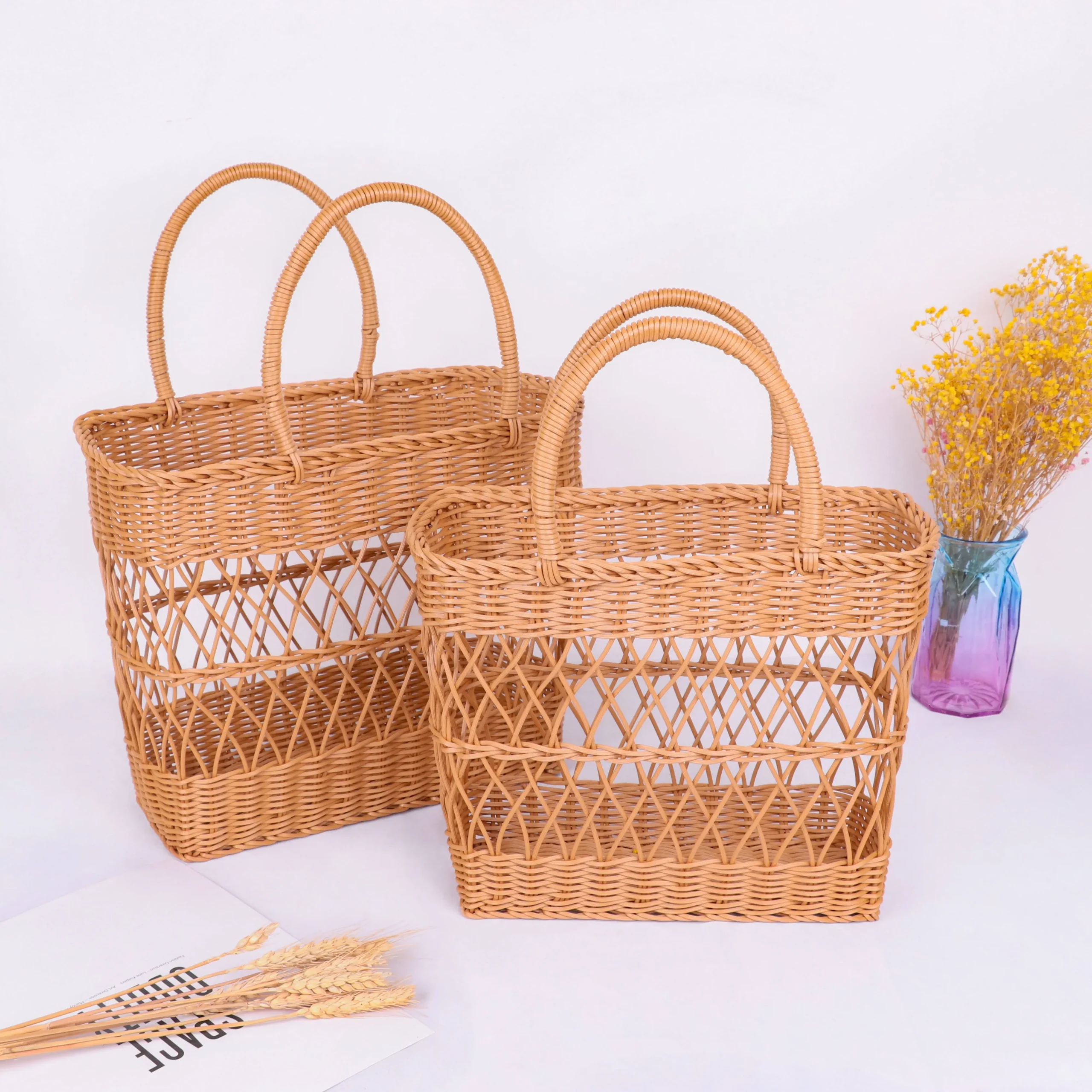
Thematic Gift Ideas
Create cohesive gift experiences through thoughtful themes:
• Culinary adventures: Regional food specialties with appropriate serving items
• Self-care collections: Bath products, candles, and comfort items
• Hobby enthusiast: Tools and supplies for specific interests like gardening or crafting
• New home essentials: Practical household items with a few luxury touches
• Seasonal celebrations: Holiday-specific treats and decorative items
Presentation Techniques
Elevate your gift presentation with these approaches:
• Layering: Place taller items toward the back, creating depth and dimension
• Color coordination: Choose items that complement each other visually
• Negative space: Allow some empty space rather than overcrowding
• Base fillers: Use crinkle paper, tissue, or excelsior to elevate items and create stability
• Wrapping: Consider clear cellophane to showcase the arrangement while protecting contents
The most thoughtful gift hampers and baskets consider both the recipient’s preferences and how the container itself might be repurposed after the contents are enjoyed. Selecting a high-quality hamper or basket that matches the recipient’s decor ensures your gift continues giving long after the consumable contents are gone.
Creating Organizational Systems with Hampers and Baskets
Hampers and baskets become powerful organizational tools when used systematically throughout your home. Creating cohesive systems rather than using isolated storage pieces maximizes their effectiveness.
Organizational Principles
Effective storage systems follow these principles:
• Categorization: Group similar items together
• Accessibility: Make frequently used items most accessible
• Visibility: Balance what’s visible and what’s concealed
• Flexibility: Create systems that can adapt to changing needs
• Maintenance: Design systems that are easy to maintain
The comparison between laundry hampers vs baskets demonstrates how different storage options serve different organizational needs within a single category (laundry management).
Room-by-Room Organization Strategies
Tailored approaches for different spaces:
Bathroom Organization:
• Use small baskets for daily toiletries on counters
• Place medium baskets on shelves for towels and extra supplies
• Position hampers for dirty linens in corners or closets
Kitchen Organization:
• Small baskets for produce on countertops
• Medium baskets in pantries for categorizing snacks or baking supplies
• Lidded hampers for bulk storage of potatoes or onions
Living Room Organization:
• Decorative baskets for remote controls and electronic accessories
• Medium baskets for magazines and books
• Larger baskets for throw blankets and pillows
Bedroom Organization:
• Hampers for clothing in closets
• Decorative baskets on dressers for jewelry or accessories
• Under-bed baskets for seasonal storage
Space-Maximizing Strategies
Make the most of available space:
• Vertical stacking: Use stackable baskets to utilize height
• Nesting: Store smaller baskets inside larger ones when not in use
• Wall mounting: Install basket systems on walls for zero floor footprint
• Door hanging: Utilize over-door systems with baskets for additional storage
• Under-furniture solutions: Low-profile baskets that slide under beds or sofas
The most effective organizational systems combine different types of hampers and baskets to address various needs. For instance, using open baskets for frequently accessed items alongside hampers for items that should be concealed creates balance while maximizing functionality.
FAQ: Common Questions About Choosing Between Hampers and Baskets
Can hampers be used for decorative purposes?
Yes, hampers can absolutely serve as decorative elements. Look for hampers with distinctive weaving patterns, attractive materials, or unique designs that complement your décor. Many high-quality hampers are designed to be displayed prominently rather than hidden away. For best results, choose hampers with proportions that work well in your space and materials that coordinate with your existing color scheme and textures.
Are baskets sturdy enough for heavy items?
Many baskets are designed to handle substantial weight, but this varies by construction. Look for baskets with reinforced bottoms, tight weaving, and sturdy handles if you plan to store heavier items. Natural materials like thick rattan or heavy-duty water hyacinth generally support more weight than lightweight seagrass or paper rope designs. For very heavy items, consider baskets with solid wooden bases or metal frames for additional support.
Which option is better for humidity-prone spaces like bathrooms?
For high-humidity areas, synthetic materials typically outperform natural fibers. If you prefer natural materials, treated rattan or bamboo with protective coatings resist moisture better than untreated options. Ensure adequate ventilation in humid spaces, and consider using basket liners for additional protection. For hampers storing damp towels or clothing, look for designs with ventilation features to prevent mildew.
How do I prevent wicker from fraying or breaking?
Regular maintenance is key to preventing damage. Keep wicker items away from direct sunlight and extreme temperature fluctuations. Apply wood oil or furniture polish occasionally to maintain flexibility. Address minor fraying immediately by trimming loose ends and applying a small amount of clear wood glue to secure the area. For baskets that receive heavy use, reinforce stress points with additional weaving or clear-drying glue as preventative maintenance.
Are there space-saving options for small homes?
Yes, many space-efficient options exist for smaller living spaces. Consider collapsible fabric hampers that can be folded when not in use, nesting basket sets that store one inside another, or wall-mounted basket systems that utilize vertical space. Multi-functional pieces like hampers with seating tops or baskets that slide under furniture maximize utility without requiring additional floor space. In studio apartments or small rooms, choose pieces that serve multiple functions whenever possible.
Which is more child-friendly or pet-friendly?
For homes with young children or pets, look for sturdy baskets with smooth, finished edges to prevent splinters or injuries. Avoid hampers with lids that could pinch little fingers. Heavy-bottomed designs resist tipping when children pull on them. For pets that chew, synthetic materials generally withstand damage better than natural fibers. Consider rounded corners rather than sharp edges, and ensure any hampers are stable enough not to tip if bumped by energetic children or animals.

